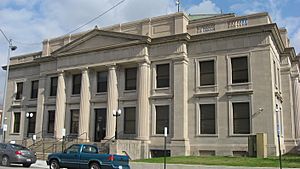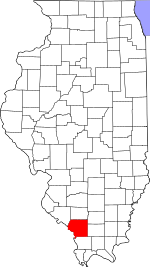Jackson County, Illinois facts for kids
Quick facts for kids
Jackson County
|
|
|---|---|

Jackson County Courthouse in Murphysboro
|
|

Location within the U.S. state of Illinois
|
|
 Illinois's location within the U.S. |
|
| Country | |
| State | |
| Founded | January 10, 1816 |
| Named for | Andrew Jackson |
| Seat | Murphysboro |
| Largest city | Carbondale |
| Area | |
| • Total | 602 sq mi (1,560 km2) |
| • Land | 584 sq mi (1,510 km2) |
| • Water | 18 sq mi (50 km2) 3.0% |
| Population
(2020)
|
|
| • Total | 52,974 |
| • Estimate
(2023)
|
52,141 |
| • Density | 88.00/sq mi (33.976/km2) |
| Time zone | UTC−6 (Central) |
| • Summer (DST) | UTC−5 (CDT) |
| Congressional district | 12th |
Jackson County is a county located in the U.S. state of Illinois with a population of 52,974 at the 2020 census, the county is located 98 miles southeast of St. Louis. Its county seat is Murphysboro, and its most populous city is Carbondale, home to the main campus of Southern Illinois University. The county was incorporated on January 10, 1816, and named for Andrew Jackson. The community of Brownsville served as the fledgling county's first seat. Jackson County is included in the Carbondale-Marion, IL Metropolitan Statistical Area. It is located in the southern portion of Illinois known locally as "Little Egypt".
Contents
History
Human occupation of Jackson County began about 11,500 years ago. Extensive documentation of the area's indigenous peoples is ongoing. Exploration from the European explorers began with the Joliet-Marquette exploration along the Mississippi River. It was not until the 18th and 19th century when pioneer farmers began to settle in the area's inexpensive land along the Mississippi River and in the forested Shawnee hills with its one-hundred-foot trees.
As early as 1810 William Boone and his indentured servant Peter mined coal from the banks along Big Muddy River. This was Illinois' first coal mine. By 1813, Conrad Will, namesake of Will County, conducted a large salt extraction operation using slave labor on the banks of the Big Muddy River, south of today's Murphysboro. As this was in the "free" Northwest Territory, Will had to have a legal exemption to own slaves. Jackson County, Illinois' ninth county to be organized, was organized in 1816, having been carved out of Randolph County, Illinois on the north and Johnson County, Illinois on the South. It was named for Andrew Jackson, who had just defeated the British Army at the Battle of New Orleans. Brownsville, located near Will's salt works, was established as the county seat. When the courthouse burned in 1843, the county voted to move the county seat to a more central location. Murphysboro, located on land owned by Dr. John and Elizabeth (Jenkins) Logan, became the second county seat in September 1843. It was named after William C. Murphy, one of the three Commissioners appointed to select the site.
Civil War Major General John A. Logan, Dr. John and Elizabeth Logan's son, was born in what is now Murphysboro on February 9, 1826. During the Civil War he moved to Carbondale, about 10 miles (16 km) east of his birthplace. He moved to Chicago in 1871. During his residence in Carbondale, he took part in a Memorial Day observation at that city's Woodlawn Cemetery. In 1868, Logan, as Commander of the Grand Army of the Republic, issued General Order No. 11 which established Memorial Day as a national holiday.
On March 18, 1925, the great Tri-State Tornado ripped through Jackson County, leaving devastation in its path. The villages of Gorham and De Soto and the city of Murphysboro were hit especially hard.
The county courthouse is in downtown Murphysboro. The current reinforced concrete courthouse, completed in 1928, replaced earlier brick structures.
Geography
According to the US Census Bureau, the county has a total area of 602 square miles (1,560 km2), of which 584 square miles (1,510 km2) is land and 18 square miles (47 km2) (3.0%) is water. The average elevation is around 400 feet (120 m), except near the Mississippi River.
The first coal mine in Illinois was opened on the south bank of the Big Muddy River near the present-day Route 127 Bridge.
Climate and weather
| Weather chart for Murphysboro, Illinois | |||||||||||||||||||||||||||||||||||||||||||||||
|---|---|---|---|---|---|---|---|---|---|---|---|---|---|---|---|---|---|---|---|---|---|---|---|---|---|---|---|---|---|---|---|---|---|---|---|---|---|---|---|---|---|---|---|---|---|---|---|
| J | F | M | A | M | J | J | A | S | O | N | D | ||||||||||||||||||||||||||||||||||||
|
2.9
39
21
|
3
45
24
|
4.3
55
33
|
4.5
66
42
|
4.8
76
52
|
4.8
84
61
|
3.4
88
66
|
3.9
87
63
|
3.1
80
55
|
2.9
69
43
|
4.6
55
35
|
3.7
44
26
|
||||||||||||||||||||||||||||||||||||
| temperatures in °F precipitation totals in inches source: The Weather Channel |
|||||||||||||||||||||||||||||||||||||||||||||||
|
Metric conversion
|
|||||||||||||||||||||||||||||||||||||||||||||||
In recent years, average temperatures in the county seat of Murphysboro have ranged from a low of 21 °F (−6 °C) in January to a high of 88 °F (31 °C) in July, although a record low of −25 °F (−32 °C) was recorded in January 1977 and a record high of 113 °F (45 °C) was recorded in August 1930. Average monthly precipitation ranged from 2.91 inches (74 mm) in January to 4.78 inches (121 mm) in May.
Major highways
Transit
Local
- Jackson County Mass Transit District
- Saluki Express
- South Central Transit
Intercity
- Amtrak at Carbondale station
- Greyhound Lines
- List of intercity bus stops in Illinois
Adjacent counties
- Perry County (north)
- Franklin County (northeast)
- Williamson County (east)
- Union County (south)
- Cape Girardeau County, Missouri (southwest)
- Perry County, Missouri (west)
- Randolph County (northwest)
Protected areas
- Crab Orchard National Wildlife Refuge (part)
- Shawnee National Forest (part)
- Giant City State Park
Demographics
| Historical population | |||
|---|---|---|---|
| Census | Pop. | %± | |
| 1820 | 1,542 | — | |
| 1830 | 1,828 | 18.5% | |
| 1840 | 3,566 | 95.1% | |
| 1850 | 5,862 | 64.4% | |
| 1860 | 9,589 | 63.6% | |
| 1870 | 19,634 | 104.8% | |
| 1880 | 22,505 | 14.6% | |
| 1890 | 27,809 | 23.6% | |
| 1900 | 33,871 | 21.8% | |
| 1910 | 35,143 | 3.8% | |
| 1920 | 37,091 | 5.5% | |
| 1930 | 35,680 | −3.8% | |
| 1940 | 37,920 | 6.3% | |
| 1950 | 38,124 | 0.5% | |
| 1960 | 42,151 | 10.6% | |
| 1970 | 55,008 | 30.5% | |
| 1980 | 61,522 | 11.8% | |
| 1990 | 61,067 | −0.7% | |
| 2000 | 59,612 | −2.4% | |
| 2010 | 60,218 | 1.0% | |
| 2020 | 52,974 | −12.0% | |
| 2023 (est.) | 52,141 | −13.4% | |
| US Decennial Census 1790-1960 1900-1990 1990-2000 2010-2013 |
|||
As of the 2010 United States Census, there were 60,218 people, 25,538 households, and 12,621 families residing in the county. The population density was 103.1 inhabitants per square mile (39.8/km2). There were 28,578 housing units at an average density of 48.9 per square mile (18.9/km2). The racial makeup of the county was 77.8% white, 14.3% black or African American, 3.2% Asian, 0.4% American Indian, 0.1% Pacific islander, 1.6% from other races, and 2.6% from two or more races. Those of Hispanic or Latino origin made up 4.0% of the population. In terms of ancestry, 26.0% were German, 14.5% were Irish, 10.6% were English, and 5.7% were American.
Of the 25,538 households, 23.0% had children under the age of 18 living with them, 35.5% were married couples living together, 10.2% had a female householder with no husband present, 50.6% were non-families, and 35.1% of all households were made up of individuals. The average household size was 2.20 and the average family size was 2.87. The median age was 29.1 years.
The median income for a household in the county was $32,169 and the median income for a family was $50,787. Males had a median income of $42,747 versus $31,244 for females. The per capita income for the county was $19,294. About 17.4% of families and 28.5% of the population were below the poverty line, including 32.1% of those under age 18 and 7.9% of those age 65 or over.
Economy
Much of the county's economic situation is dependent upon Southern Illinois University Carbondale and the city of Carbondale. A rapidly developing city, it is part of the Metro Lakeland area consisting mainly of the major communities of Carbondale, Marion, Herrin, and Carterville. The outer regions of the Metro include Murphysboro, the rest of Jackson County, the rest of Williamson County, Perry County, and Saline County. Jackson County is also located near the Shawnee Hills Wine Trail.
Communities
Cities
- Ava
- Carbondale
- Grand Tower
- Murphysboro (seat)
Villages
Census-designated place
Unincorporated communities
Ghost town
Townships
- Bradley
- Carbondale
- DeSoto
- Degognia
- Elk
- Fountain Bluff
- Grand Tower
- Kinkaid
- Levan
- Makanda
- Murphysboro
- Ora
- Pomona
- Sand Ridge
- Somerset
- Vergennes
See also
 In Spanish: Condado de Jackson (Illinois) para niños
In Spanish: Condado de Jackson (Illinois) para niños





